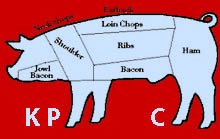
The Western half of the Metro's Orange Line is Washington's economic lifeline, the subterranean Via Appia of the New Rome. I pick it up from the Red Line at Metro Center, the city's depressing underground transport hub. It's still early rush hour, so I manage to find a seat next to a bespectacled man in his 50's reading a Tom Clancy geopolitical thriller.
I take in my fellow-passengers on the train. Grey-faced office workers gazing out the black windows of the train as it hurdles towards Virginia, watching the walls of the tunnel as it passes. At Foggy Bottom, the stop for the State Department and George Washington University, my neighbor gets off, and is replaced by a sweating 5,000-pound Hippo of a man who grunts as he plops down beside me.
We scoot under the Potomac River and enter America's Second Capital, the chain of Orange Line boomtowns between Rosslyn and Vienna.
If Washington DC is the brain of America, then the western half of the Orange Line forms its pulsating hypothalamus, the "master gland" of the world' sole superpower.
No one has benefited more from Reaganism than Fairfax County, Virginia. For die-hard conservatives, the Gipper "shrunk the federal government" and crushed the sprawling New Deal Federal bureaucracies. For people who live in a world constrained by empirical data, however, he simply began the process of contracting out the civil services. Policymaking was now open for business. Today, the "public-private partnership" is to Fairfax and Arlington Counties what petroleum is to Dubai.
Anyone who is anyone in America (or the World) maintains an outpost here.

I get off at Ballston, along with my sweaty Gargantua of a fellow-passenger. Posters for Lockheed Martin (motto: "We never forget who we're working for") adorn the grey, retrofuturistic walls of the station. Some defiant teenager has drawn hairy cocks and balls hanging from the helicopters. It warms my heart.
I emerge from the escalator into a colorless vacuum. The architecture that greets me is remarkable only for its oppressive sameness. Wide, rubbish-free streets and sidewalks lined by giant working-hives of concrete and glass. A few restaurants with uninviting outdoor seating do little to disrupt the monotonous cityscape. Even the cars on the street avoid distinction- sedan SUV sedan SUV, all newish and well-kept.
I wonder how a civilization at its supposed peak can produce such a place. Napoleon III left the Champs-Elysees, the Almoravids built the Alhambra. Our legacy is the office park.
I'm early so I sit and order a coffee from a Middle Eastern place called "Aladdin's." It is awful to drink but I force it down.
On the street, a parade of the undead passes by, thousands of shapeless professionals shuffling to their stations. The coffee, amazingly, costs $2.15. I leave 3 on the table and join the parade.


2 comments:
This is so right on. Ballston is a bad example, as it is basically a suburban town center with tall buildings. Clarendon and Rosslyn are a bit more lifelike, but I agree with you that Northern Virginia, while stupendously wealthy, is also depressing.
I'm out in Reston, which is, in many ways, worse. All along the toll road there are these enormous corporate campuses—for Oracle, Unisys, Northrop Grumman, Nissan, Airbus, Sprint, and a host of tech companies (like CA) I could barely identify. Everything is really shiny and expensive, but there's no life—none—after 10 pm. No friendly culture or way of meeting people, barely any bars.
But there are vast swaths of DC that are like that as well, mostly clustered near the Mall—empty shells of office buildings with tiny lunch delis on the first floor.
Most American Cities have some version of What DC has south of Massachussetts Avenue- business districts that clear out after work, with the exception of hotel bars and the occasional Happy Hour joint.
But north of Massachussets there is actually a bit of personality.
I want to reread "City Of Quartz"-- about LA, but on the same theme.
Post a Comment